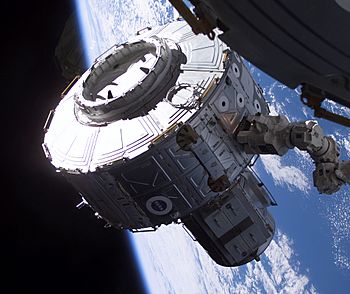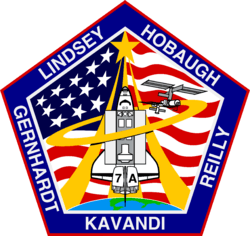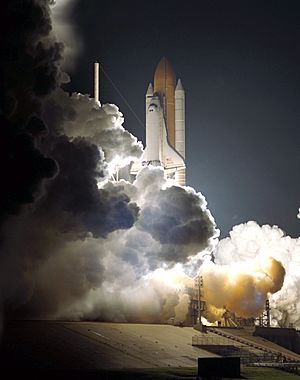STS-104 facts for kids

Quest being grappled by Canadarm2, prior to its installation on the ISS
|
|
| Mission type | ISS assembly |
|---|---|
| Operator | NASA |
| Mission duration | 12 days, 18 hours, 36 minutes, 39 seconds |
| Distance travelled | 8,500,000 kilometres (5,300,000 mi) |
| Orbits completed | 200 |
| Spacecraft properties | |
| Spacecraft | Space Shuttle Atlantis |
| Launch mass | 117,129 kilograms (258,225 lb) |
| Landing mass | 94,009 kilograms (207,254 lb) |
| Payload mass | 8,241 kilograms (18,168 lb) |
| Crew | |
| Crew size | 5 |
| Members |
|
| EVAs | 3 |
| EVA duration | 16 hours, 30 minutes |
| Start of mission | |
| Launch date | 12 July 2001, 09:04 UTC |
| Launch site | Kennedy LC-39B |
| End of mission | |
| Landing date | 25 July 2001, 03:38 UTC |
| Landing site | Kennedy SLF Runway 15 |
| Orbital parameters | |
| Reference system | Geocentric |
| Regime | Low Earth |
| Perigee | 372 kilometres (231 mi) |
| Apogee | 390 kilometres (240 mi) |
| Inclination | 51.6 degrees |
| Period | 92.2 minutes |
| Docking with ISS | |
| Docking port | PMA-2 (Destiny forward) |
| Docking date | 14 July 2001 03:08 UTC |
| Undocking date | 22 July 2001 04:54 UTC |
| Time docked | 8 days, 1 hour, 46 minutes |
  Left to right: Seated - Charles O. Hobaugh, Steven W. Lindsey; Standing - Michael L. Gernhardt, Janet L. Kavandi, James F. Reilly |
|
STS-104 was a Space Shuttle mission to the International Space Station (ISS). The mission was flown by Space Shuttle Atlantis. Its main goal was to deliver and install a special room called the Quest Joint Airlock. This airlock is super important for astronauts to go on spacewalks.
The mission launched on July 12, 2001. After successfully connecting to the ISS and installing the new equipment, Atlantis returned to Earth safely. The astronauts also performed three spacewalks during their time in space.
Contents
Meet the Astronauts
| Position | Astronaut | |
|---|---|---|
| Commander | Steven W. Lindsey Third spaceflight |
|
| Pilot | Charles O. Hobaugh First spaceflight |
|
| Mission Specialist 1 | Michael L. Gernhardt Fourth and last spaceflight |
|
| Mission Specialist 2 | Janet L. Kavandi Third and last spaceflight |
|
| Mission Specialist 3 | James F. Reilly Second spaceflight |
|
The STS-104 mission had a crew of five brave astronauts. This was one of the last Space Shuttle missions to have only five crew members. Later missions usually had six or seven astronauts.
Mission Highlights: What Did They Do?
The most important part of the STS-104 mission was to bring and attach the Quest airlock to the International Space Station. Think of an airlock as a special doorway that lets astronauts move between the inside of the space station and the vacuum of space.
The Quest Airlock: A Special Doorway to Space
The Quest Joint Airlock is made of two cylinder-shaped rooms connected together. Once it was installed and ready, it became the main way for astronauts to leave and enter the ISS for spacewalks. It works with both the American spacesuits (called Extravehicular Mobility Units, or EMUs) and the Russian Orlan spacesuits.
The Quest airlock is about 6.1 meters (20 feet) long and 4 meters (13 feet) wide. It weighs about 5.9 metric tons (6.5 short tons). It's built from strong steel and aluminum. This amazing piece of equipment was made by Boeing at the Marshall Space Flight Center.
The airlock has two main parts:
- One part is for the astronauts to get ready and go outside.
- The other part is for storing all their spacewalk gear.
STS-104 also carried four large gas tanks. These tanks were attached to the outside of the airlock.
Spacewalks: Working Outside the ISS
Astronauts Michael Gernhardt and James Reilly performed three spacewalks during this mission. They spent a total of 16 hours and 30 minutes working outside the Space Shuttle Atlantis and the ISS.
- Spacewalk 1: Gernhardt and Reilly helped install the Quest airlock.
- Spacewalks 2 & 3: They focused on adding important parts to the outside of the Quest airlock. This included attaching the four large gas tanks, handrails, and other necessary equipment. The third spacewalk was actually started from inside the new Quest airlock itself!
Wake-up Calls: Music in Space
NASA has a fun tradition of playing music to wake up astronauts in space. This started way back during the Gemini program and became a regular thing with Apollo 15. The songs are often chosen by the astronauts' families. Each song usually has a special meaning for an astronaut or relates to what they'll be doing that day.
| Flight Day | Song | Artist/Composer | Links |
|---|---|---|---|
| Day 2 | "Wallace Courts Murron" | Braveheart Soundtrack | wav mp3 Transcript |
| Day 3 | "God of Wonders" | Caedmons Call | wav mp3 Transcript |
| Day 4 | "Space Cowboy" | 'N Sync, from the soundtrack to Space Cowboys | wav mp3 Transcript |
| Day 5 | "No Woman, No Cry" | Bob Marley | wav mp3 Transcript |
| Day 6 | "Nobody Does it Better" | Carly Simon, from the soundtrack to The Spy Who Loved Me | wav mp3 Transcript |
| Day 7 | "Happy Birthday, Darling" | Conway Twitty | wav mp3 Transcript |
| Day 8 | "All I Wanna Do" | Sheryl Crow | wav mp3 Transcript |
| Day 9 | "A Time to Dance" | Space Center Intermediate School Symphonic Band | wav mp3 Transcript |
| Day 10 | "I Could Write a Book" | Harry Connick Jr., from the soundtrack to When Harry Met Sally... | wav mp3 Transcript |
| Day 11 | "Who Let the Dogs Out?" | The Baha Boys | wav mp3 Transcript |
| Day 12 | "Orinoco Flow" | Enya | wav mp3 Transcript |
| Day 13 | "Honey, I'm Home" | Shania Twain | wav mp3 Transcript |
| Day 14 | "Hold Back the Rain" | Duran Duran | wav mp3 Transcript |
Images for kids
See also
 In Spanish: STS-104 para niños
In Spanish: STS-104 para niños


